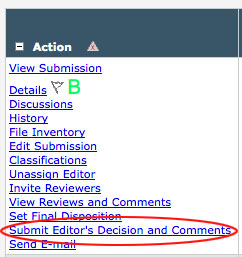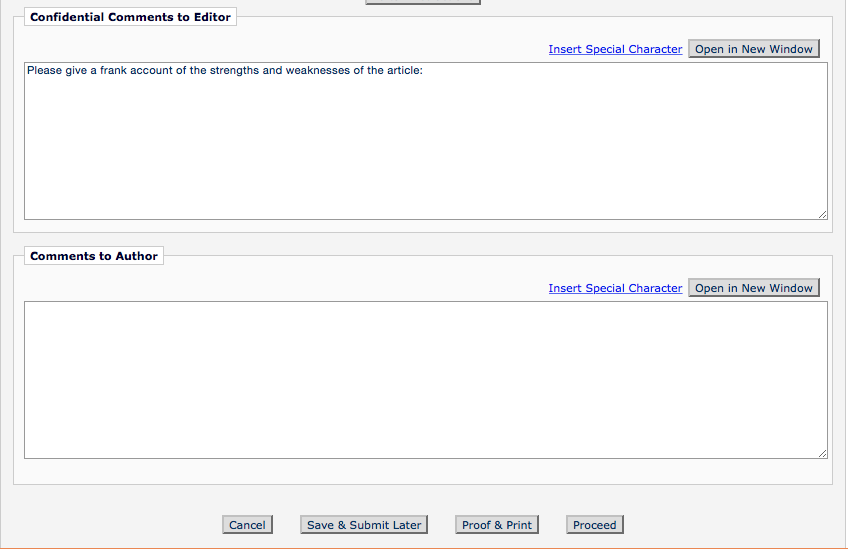The role of the Associate Editor (AE) is to assist the Editors in making a decision about the final disposition of a manuscript by synthesizing the findings of expert reviewers and offering perspectives on the work that come with more specialized knowledge of the language or subject area than the Editor might have.
AE assignments
AEs usually take on an assignment after the paper has passed a Technical Check for formatting, anonymization, etc., and been assigned to an Editor (Doris or Jack). AEs are asked to volunteer to handle a paper and to suggest the names of potential reviewers to the Editor and Managing Editor (Joe) at this stage, and then the paper is sent out for review by the Managing Editor. Typically, two reviewers will be invited to read the paper, and once the reviews are complete the file is passed to the AE, who reads the article, the reviews, and writes a report. The report is due within four weeks of assignment (though the faster it is done the better).
The way the report will go, of course, depends on the outcome being recommended, and also how thorough the reviews are. If the reviewers do a good job, and if they agree, and the AE agrees with them, then writing the report is pretty straightforward. If reviewers disagree, then AE report becomes essential in helping the Editor make a final decision.
Usually the report has three sections: the recommendation with a summary of the gist of the reviews, a discussion of substantive organizational problems or analytical shortcomings along with recommendations on how to fix them, and a list of minor corrections/typos that were missed by the reviewers. The report should make reference to the most important issues highlighted by the reviewers as well as additional or more global considerations originating with the AE.
One thing to keep in mind is that we are very constrained for space in IJAL. If there anything that can be done to shorten papers, or if there are some materials that could appear as appendices on-line only, that can be brought to the attention of the Editor.
From the Editor’s perspective, it is important that the AE report contain a clear recommendation that falls into one of the following categories:
- accept as is
- accept with minor revisions (paper subject to subsequent editorial scrutiny)
- revise and resubmit (paper subject to subsequent peer review)
- reject (paper unsuitable and/or would require major reconceptualization)
The decision “accept with minor revisions” here means that the paper would not normally go back to an external reviewer, whereas “revise and resubmit” indicates the necessity of further peer review. In either case, the AE should construct a “road map” for the author of how exactly to improve/repair/finalize the paper.
If the paper is clearly “reject” to all concerned, then the AE report need only briefly and succinctly make the case for rejection and not spend too much time trying to salvage the paper. In cases where there is no clear agreement among the reviewers but the AE feels the paper should be rejected (or the AE disagrees with both reviewers and feels the paper should be rejected), the AE report should make a strong argument for that position and give enough detail that the Editor would be able to sustain that decision in discussions with the author.
If the decision is “revise and resubmit,” when the revised paper comes back, it is usually returned to the same AE that read it the first time, and one or more of the original reviewers (depending on the extent of the requested revisions, the quality and relevance of the reviews, etc.). The AE may make recommendations about which reviewers to use, but it is better not to include this kind of information in the AE report that goes to the author. The AE reports and all reviews are made available to the reviewers at the end of the submission process, so please address comments and recommendations about reviewers directly to the Editor.
Resubmission
When a paper is returned to an author, they receive anonymized copies of all reviews, the AE report, and the Editor’s decision. Authors are asked to supply a letter containing their responses to the reviewers and to the AE report, along with a detailed list of the changes that have been made to the paper. Once the second round of reviews is completed, the reviews go back to the AE, who again prepares a report and a recommendation to the Editor.
The second report is much the same as the first report, although it should explicitly deal with the degree to which the author has compiled with the requested revisions and the extent to which these revisions have (or have not) dealt with the problems highlighted in the first round of revisions. The report should include a specific recommendation using the categories suggested above, which may very well include the recommendation that the paper be revised and resubmitted for a third round of review.
Working through the EM
The entire review process is handled through the on-line Editorial Manager (EM). From the AE’s perspective this means that in the usual course of events they will receive a series of notices from the EM and then will log in to the system to access papers and reviews, and to submit their own reports.
Generally, the first notice of a possible assignment will be the beginning of a Discussion calling for volunteers to take on a paper and for suggestions for potential reviewers. AEs participate in these discussions by logging messages into a message board in the EM. If there are no volunteers for a paper, the Editors will begin approaching individuals they think would be appropriate.
When the paper is assigned, the AE receives notification and the option to decline the assignment in the form of an email with links to the on-line system. Again, links to the paper in the EM are provided in the body of the notification e-mail.
These links take the AE to a tabular view of information relating to the paper (manuscript number, title, etc.). AEs access reviews and submit decisions by selecting links from the “Action” menu in the lefthand column of the table. Decisions are submitted via the “Submit Editor’s Decision and Comments” link circled in the screenshot below.

When submitting a decision, the AE is shown a window with three components. The first is a drop-down menu near the top of the screen where the decision category is selected.
Below that, there is a series of links through which other types of information about the submission can be accessed. Most importantly, there is a link called “Attachments” which allows the AE to upload and download files associated with the paper, including their own AE report if it has been prepared ahead of time as a PDF or word-processor file.
![]()
If you are going to attach your report or part of the report in the form of an uploaded document, please title that document “AE Report” and include the manuscript number in the title (e.g., “2014088 AE Report”). This will help the author keep track of which set of comments are whose.
The page also has two large text fields, one for comments that will be forwarded along with the reviews to the author, and one for comments directed solely to the Editor.

“Confidential Comments to Editor” are not required, though this is the place for especially frank commentary or commentary on the review/reviewer (please do not criticize reviewers in your report). The AE report for the author can be typed or pasted into the “Comments to Author” field or, as noted above, the report can be uploaded as an attachment via the “Attachments” link, as can a marked-up copy of the paper itself.
Once completed, this form can be submitted by clicking on the “Proceed” button at the bottom of the screen.
Questions about using the EM can be sent to the Managing Editor, Joe Muszynski.
